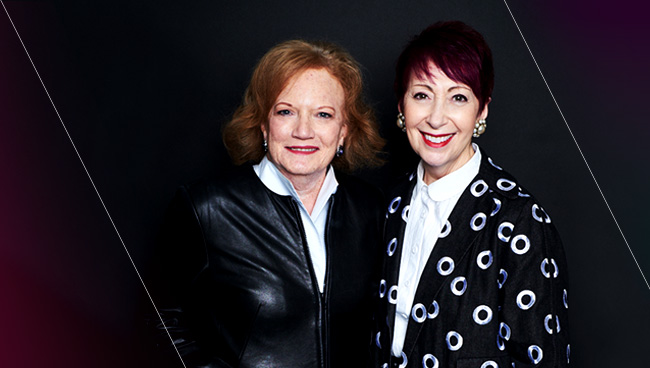Wendy Liebmann and Candace Corlett, WSL Strategic Retail’s managing partners, continue the previous discussion and talk bluntly about the fact that there is no going back. That longing for the past days of retail – pre-pandemic – is irrelevant and dangerous. They discuss how retail has not been “a happy place” for shoppers for a long time, that the pandemic merely exacerbated the situation. They discuss how to connect emotionally with shoppers in a digital world, where brands fit, the movement to smaller stores, and how shoppers are dealing with the recession.
Wendy [00:00:02] Hello, I’m Wendy Liebman, CEO and chief shopper of WSL Strategic Retail. And this is Future Shop. This is the second part of a discussion in the series that we are calling six months in. Now what? My guest again is Candace Colette, president of WSL, my business partner and good friend.
Wendy [00:00:26] Where we left off was that we were actually talking about how the store, as we know it, has been transformed overnight in a period of six months. Shoppers have learned very quickly how to adapt and take control in this pandemic in this part of the discussion. Candace, I’m going to talk about how we can, as an industry, as retailers, as brands, no longer look backwards, dreams of other years. And now we need to think about what retail needs to do to reset in this new world.
Wendy [00:01:08] You know, when we talk to retailers and cross-channel, I don’t care whether it’s, you know, a mass big box or it’s a specialty retailer, whether it’s us or global. We have this sort of old world view of what retail was. This pandemic has now shifted that way. There is no luxury of looking back the way we did. And we’ve often said, you know, what got you here will not get you to the next normal.
Candace [00:01:39] I think it’s a very long ago longing. We’ve been showing pictures of retail aisles with that big burst. This is not a happy place for a long time. And what this pandemic did was turn the apple cart over. And it’s exciting. I mean, you know, maybe future is always exciting and what’s coming next, but our clients who had two, three, four percent of their sales going through online shopping have suddenly had to say, I’ve got to find a whole new model. And that model has to include not just getting the product to the person, but how do I as a brand, emotionally connect with the shopper? That’s what retail had lost. And that’s the challenge now. If more people are clicking online to buy, how do I interrupt with my emotional message.
Wendy [00:02:42] And that whole notion of trust and what we call caring and the indices that we’ve developed around that? Who cares for me? And who do I trust? Now, of course, again, that’s that requires us to rethink. And like you, I’m very opportunistic. I mean, and very it sounds weird. Six months into be optimistic. But those things have been now for. We can’t live in an old world anymore. We can’t hazard that long, long ago. Once upon a time. A long time ago. Because that world just doesn’t exist. And so I think that’s one of the big opportunities for people. And we see it with the clients who get it and those who don’t. How do they how do we help them rethink that that model and that message they have to deliver. So what you see is some of the big opportunities in all our work.
Candace [00:03:38] Well, the first is, as you said, clients accepting the message, oh, people will go back to the stores. You know, even if a third of the people who bought groceries online for the first time during the pandemic don’t go back to the stores. That’s a very big number. And we have a lot of smart clients who will set up task forces to say how do we represent our brands when the only interaction we have is click? What are we going to do to present our brands, to make them valuable? Because on a screen they’re all equal. And that is I sort of like become a little bored with the screen shopping because everything is all equal. I’d like a little adventure.
Wendy [00:04:27] Well, you know, Craig Dubitsky, when he was on the podcast, made a comment about the opportunity to win to improve the experience, the digital shopping experience. He said, we’ve got it down pat. It’s like we know the milk’s at the back of the store. He also said, we know in the top right corner there’s, you know, your cart right. You know, we sort of know how it works. And he, too, is as a wonderful entrepreneur. Who thinks about creating amazing toothpaste brands called Hello. You know, he said that he said there’s so much opportunity now for retailers and manufacturers and pure play digital companies to reinvasion the experience of shopping in a digital space as well. And that’s what you’re talking about.
Candace [00:05:14] Yes. And it’s going to be it has to be driven by I want my brand to be special. I don’t want it to just be a package picture on a screen. So that’s certainly one thing. The second thing is this movement towards small stores. I was shocked at our last set of information. You know, a quarter of shoppers have been in Target Express or a neighborhood market in the last three months. It’s now their store of choice and small formats used to have pushback from shoppers because I like a small format as long as you have everything in that format that I want. And now if you don’t have it, that’s OK, I’ll go online and I’ll order it and I’ll do curbside pickup. So the first big shift has been, I don’t have to walk home with it today. If you don’t have it, I can order it and I’ll have it tomorrow. Most things, that’s just fine. The second shift is, as you said at the beginning, smaller space, less space for brands to present themselves. What does that mean for branding? I am most concerned about our brand partners. Shoppers are figuring out how to get their stuff. Retailers have already seen in six months have moved way ahead on the logistics of getting it to me. I’m worried for our brand partners because they now are missing even the end cap. You know, we may have walked past it and ignored it, but somehow the endcap resonated in our brain. How are you going to connect to me? How are you going to tell me your personality going back to national TV commercial isn’t an option. How are you going after me?
Wendy [00:07:07] And the other thing I think there. Which is sort of the extension of that is the retailers as they are really trying to understand where they go and differentiate their direct a consumer drive. You know, they’ve got the power and the ability for them to have their own brands or own exclusive brands. I mean, we see it in retail. It’s obviously like Target and CVS. You know, a lot of the retailers that that that shoppers are even buying from on a regular basis less, fewer and smaller and more unique brands that aren’t necessarily part of the national brand. And I think the other thing that struck me in that, and I’m going to interrupt myself, is over this last six months, we’ve heard a lot about big national brand companies talk about the importance. They’ve seen the growing importance and trust again in their name brands that big national name brands, whether it’s for pain or whether it’s for, you know, fill in the blanks. Right. And they’ve been very proud of that because they said it’s all about trust. And the reality is in some ways that that was a moment and maybe that was a supply chain opportunity.
Candace [00:08:26] But then I think and I think, Wendy, it was also, if I’m new at buying my basics, my pain reliever, my shampoo, my conditioner if I’m new at buying it online. The big-name brands come up first. It’s like a great. I’ll get that one. So I think there were a lot more dynamics than, oh, I want my trusted brand. Because we know in our data that new brand innovators. Creep up on trust very quickly. So you’re absolutely right. Our national name brands shouldn’t be banking on. We’re the ones people want. Now it’s more like, OK, yeah, I recognize them. And they came up first.
Wendy [00:09:13] We sort of alluded to the issues around shopping, not alluded. What we haven’t talked about here really is a recession, no recession, financial crisis.
Candace [00:09:25] You know, Wendy, six months into this, our current report on how people feel about their finances, which we’ve been tracking since about 2012. Our numbers are back to where they were in November. There are far fewer optimists, people who think, oh, my standard of living is really going to improve, my finances are going to improve. There are far fewer optimists, but half of the population out there feels financially secure. They feel they may not be getting better, but they’re not going to slip away. And it’s going to be OK.
Wendy [00:10:07] So does that address two things? One of the if it wasn’t a necessary surprise for me, but one of the things that was encouraging as we’ve seen this number from the beginning of the COVID crisis, where for all of you listening, we’ve been tracking this. And [our team] their heads are exploding because we’re in the field every whatever month or so, seeing where everybody is. But from the beginning, the number that I found most interesting and heartening in some ways is that half the population has said, I’m proud of how I’m managing in this crisis. And so is that do you see that as part of the continuity of that? I’m getting on with it. I can’t depend on anybody. I’m depending on myself as much as I can and getting on with it. Is that what you are seeing now in the financial numbers?
Candace [00:10:59] Well, it’s absolutely contributing. You know, people said, I have to figure out how to get the things I need. I have to figure out how to spend with caution because I don’t really know how solid my work will be. But the truth of it is in our samples and in the U.S. population, less than two percent of people have been sick. And I think people are now looking around and saying, OK, we made it through the worst, hopefully, March, April, May was the worst. This is very unpredictable. But a lot of people saying we made it through the worst. We know how to protect ourselves. We’re going to be careful but we’re going to be okay.
Wendy [00:11:49] So is this a which I find encouraging? And we sort I mean, this is not our first crisis.
Candace [00:11:56] You know, I was encouraging and it’s startling to me.
Wendy [00:11:58] Well, that’s what I was thinking. This this. You know, it’s encouraging because it talks about the resiliency of people, the fact that it’s not their first crisis. So for anybody, you know, 20 or something, you know, from September 11 and the world ended, you know, at a moment and places and change things from the financial crash in 2007/8. And how long it took to get back from that. So shoppers, Americans, people around the world are not stupid and have learned to trust. I think we always said they trust themselves and strangers in this world. But the other part of it is, are we taking a, you know, a privileged view here or is there half the population, those with incomes under fifty thousand dollars a year, household incomes, who actually are living in a very different place?
Candace [00:12:48] There’s no question. I mean, we look at our numbers and everything from even how you rate your perception of your personal health. Lower-income shoppers struggle more. Absolutely. But the percentage of people who feel pessimistic about their finances is the same now as it was in 2019 November of 2019 and they struggle. There’s no question, and it’s almost 30 percent of the population. That’s a big number. But in terms of retailers planning for the future, brands planning for the future. And I know the future. I mean, from now to December. I was a big I think of the future from now to December. About 70 percent of people are OK financially and going into the holiday season. That’s a big plus. We’re looking at sort of the same scenario as we were last year. The fallout eventually has to come. I mean, cities, city employees, cities and states are struggling to keep services going. And that’s just, you know, what we know about and what we see locally in our city. So it’s got. It may still becoming, but at the moment, managing well, still being employed, has about 70 percent of people feeling secure, to a little optimistic.
Wendy [00:14:35] What’s clear is there is no looking back, no longing for the old days. We now have to move forward and that’s what we’re going to talk about in our next discussion. What comes next? How to reset? How do you move forward actively? So join us for the conclusion of our discussion.
Wendy [00:15:00] See you in the near future.

















